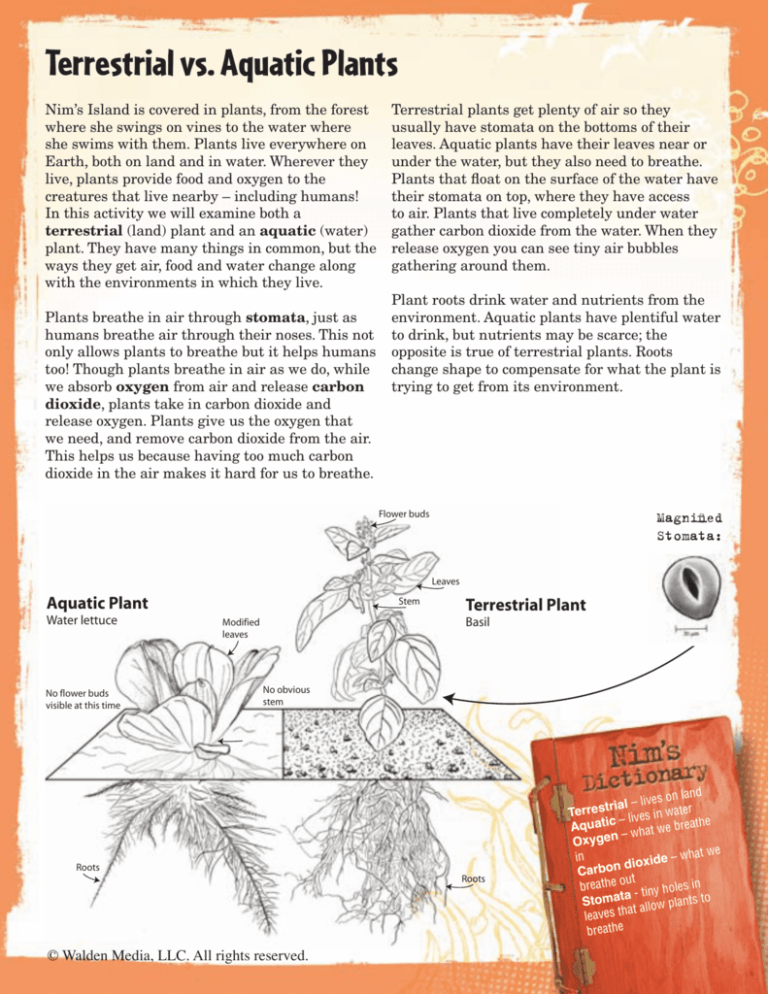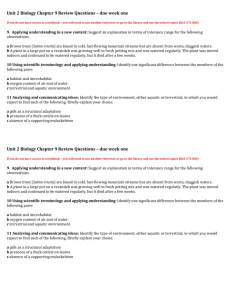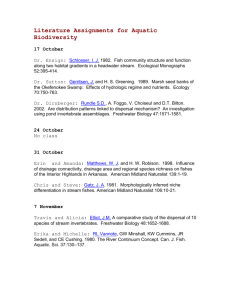
Terrestrial vs. Aquatic Plants
Nim’s Island is covered in plants, from the forest
where she swings on vines to the water where
she swims with them. Plants live everywhere on
Earth, both on land and in water. Wherever they
live, plants provide food and oxygen to the
creatures that live nearby – including humans!
In this activity we will examine both a
terrestrial (land) plant and an aquatic (water)
plant. They have many things in common, but the
ways they get air, food and water change along
with the environments in which they live.
Plants breathe in air through stomata, just as
humans breathe air through their noses. This not
only allows plants to breathe but it helps humans
too! Though plants breathe in air as we do, while
we absorb oxygen from air and release carbon
dioxide, plants take in carbon dioxide and
release oxygen. Plants give us the oxygen that
we need, and remove carbon dioxide from the air.
This helps us because having too much carbon
dioxide in the air makes it hard for us to breathe.
Terrestrial plants get plenty of air so they
usually have stomata on the bottoms of their
leaves. Aquatic plants have their leaves near or
under the water, but they also need to breathe.
Plants that float on the surface of the water have
their stomata on top, where they have access
to air. Plants that live completely under water
gather carbon dioxide from the water. When they
release oxygen you can see tiny air bubbles
gathering around them.
Plant roots drink water and nutrients from the
environment. Aquatic plants have plentiful water
to drink, but nutrients may be scarce; the
opposite is true of terrestrial plants. Roots
change shape to compensate for what the plant is
trying to get from its environment.
Magnified
Stomata:
�����������
������
�������������
�������������
���������������
��������������������
����
�����������������
�����
��������
������
�����������
����
�����
�����
© Walden Media, LLC. All rights reserved.
n land
– lives o r
l
ia
r
t
s
wate
Terre
– lives in
Aquatic what we breathe
–
Oxygen
hat we
in
xide – w
io
d
n
o
Carb
ut
breathe o tiny holes in
a
t
a
nts to
Stom
allow pla
t
a
th
s
e
leav
breathe
Terrestrial vs. Aquatic Plants
Name: ______________________________________
Date: _______________________________________
In the diagram below, identify which plant lives on land and which plant lives in water. Label the roots, stems,
leaves, and flowers on each plant. Be sure to include the following: Roots, Stems, Leaves, and Flowers.
What are the differences between terrestrial plants and aquatic plants?
How have aquatic plants adapted to be better suited to living in water?
What might happen if your plants switched environments?
This is a
This is a
_________________ plant.
_________________ plant.
© Walden Media, LLC. All rights reserved.
Terrestrial vs. Aquatic Plants
Name: ______________________________________
Date: _______________________________________
What are the differences between terrestrial plants and aquatic plants?
How have aquatic plants adapted to be better suited to living in water?
What might happen if your plants switched environments?
Look at the roots of both plants, what do you see? Draw what you see and then label the
differences between them.
How does each plant smell and feel?
Draw one aquatic plant and
one terrestrial plant from
the specimens given to you.
Identify which plant lives on
land and which plant lives
in water. Label the leaves,
stem, roots and flowers
on each plant.
© Walden Media, LLC. All rights reserved.
Terrestrial vs. Aquatic Plants
Educator Page
Exercise 1: (No plant samples needed) Use the Provided student worksheet. Have the students
label the illustration and answer questions.
Materials:
Copies of the worksheet
Pencils
Exercise 2: (Plant samples needed) Give the students examples of each of an aquatic and a
terrestrial plant. Have them do their own discovery and illustrations before answering the
questions. Good examples of plants for this exercise include Elodea (which can be found in the
aquatic sections of pet stores) and sprouted soybeans, however any convenient type of each
terrestrial or aquatic plant will work for this project. Encorage each student to look at each plant
leaf under the microscope. Ask them: what do you see? Draw what you see and then label the
differences between them.
Materials:
An aquatic plant - Enough plant material for each pair of students to work with.
A terrestrial plant - Enough plant material for each pair of students to work with.
Microscope (optional)
National Standards:
Science: NSES Grades K-4 Life Sciences
Standard C: students should be able to develop and understanding
of: the characteristics of organisms and organisms and
environments.
Visual Arts: CNAEA Standard 2: Using knowledge of structures
and functions.
English/Language Arts: NCTE/IRA Standard 8: Students use a
variety of informational resources to gather and synthesize
information and to create and communicate knowledge.
© Walden Media, LLC. All rights reserved.







